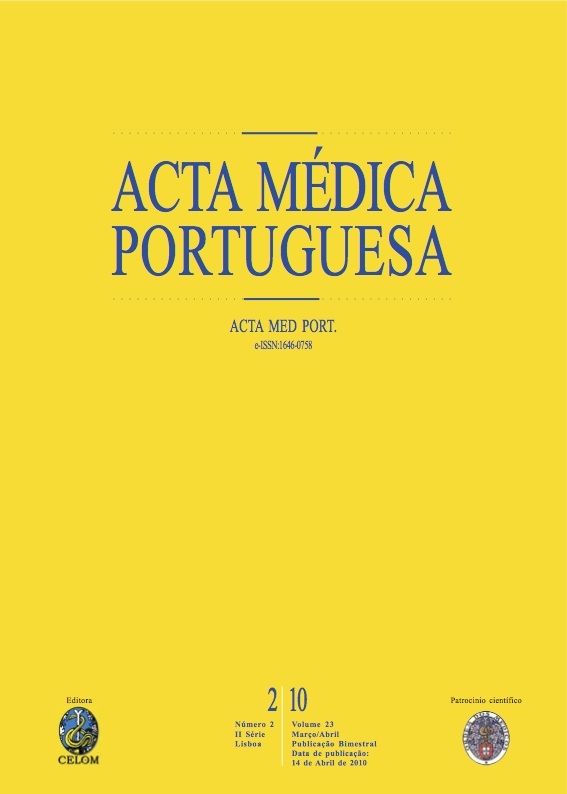Evaluation of new technologies PET/CT nuclear imaging.
DOI:
https://doi.org/10.20344/amp.601Abstract
Nuclear imaging has used initially anatomic and volumetric technologies as CT or MRI. In recent years new dimensions of non invasive studies, as PET, have shown a higher utility in the effectiveness of the treatment. The evaluation of need must be done according to a principle of Horizontal Equity, equal treatment for equal need and of a principle of Vertical Equity, Different treatment, at regional level, according to each hospital level. The evaluation of need has been made according to the Potential Demand by Potential User Groups: diabetes, type 2, (50 years and more); screening colorectal (50 years and more); morbidity by cancer; surgery of lung cancer; cardiology; heart surgery; acute chest pain in the emergency department. In a Macro Perspective need has been evaluated using the Population Estimations for 2007, at municipality level. Relatively to Lisbon and Porto data at locality level has been used, from the 2001 Census. According to Campos, J.R. (2007), in 2006, it existed 1 PET by 1 million inhabitants and after that date 2 more were created (Quadrantes and Hospital ad Luz), belonging to the private sector. Mores 15 PET are needed in the NHS, 1 PET for about 504128 inhabitants. According to The Potential Demand perspective 18 new PET are needed, 15 from the public sector. The private sector will cover progressively the demand. Dorado and Albertino (2002), in Spain, mention that the introduction of this new technique in our Health System must be done slowly due to the cost and complexity. In Portugal exists already 6 PET and this applies also. As a first priority the intervention in Oncology in the IPO (Coimbra). A priority must be given to the University Hospitals of Santa Maria and São João. The Central Hospitals of Viseu and VilaReal/Régua must have also 1 PET. A priority must be given to the interior in order to avoid transports of patients and families. In fourth place the HC Central Lisbon must have also 1 PET, which will go to the New Hospital of Todos-os-Santos. The Hospital Garcia de Orta must have also 1 PET, what will avoid the patients from the Setúbal district to come to Lisbon. The HC of Coimbra and the HC of Ocidental Lisbon must have 1 PET in order to cover the population of the Centre Region and of Lisbon Region. The HC of VN de Gaia, the Hospital Pedro Hispano, Matosinhos, and the Hospital of Guimarães, must have 1 PET due to the population density of the North Region. The New Central Hospitals of Evora and Faro must also have 1 PET and the New Hospital of Braga. The estimation of diabetes, type 2, has been made using the minimum prevalence of 3%. The prevention of cardiac illness in the population of 50 years need with diabetes, type 2, must be done with PET annual examinations in the Hospital, referred by the family doctor in the health centre. The screening colorectal has not a tradition in Portugal. Sun L et al (2008) mention that according to criteria of specificity, sensibility and precision PET/CT presents higher advantages in the colorectal screening. It has been estimated that it must be done in 10% of the adults of 50 years and more with annual examinations in the Hospital, referred by the family doctor in the health centre. The use of PET in cancer treatment must be done only in the cancer of mama; cáncer colorectal; cancer of esofagus; cancer of head and neck; lung cancer; linfoma; melanoma; and Solitary Pulmonary Nodules; cancer of thyroid; cancer cervical . Those types of cancer are 46,7 % of total cancer mortality. The use of PET in cardiology in CAD is also important. If the prevalence of CAD is less than 70% PET has a lower value per QALY. The number foreseen of examinations is of about 3114 examinations/ year. The application of Pet in acute chest pain makes that the localization of PET must be done near the Emergency Department. Mowatt, G. et al. (2008) conclude that, based in some studies of Acute Chest Pain there is an evidence of prognostic that the use of 64-slice CT has influence in the way as patients are treated, what gives origin to a reduction in some inpatient care and avoids the development of invasive CAD.Downloads
Downloads
How to Cite
Issue
Section
License
All the articles published in the AMP are open access and comply with the requirements of funding agencies or academic institutions. The AMP is governed by the terms of the Creative Commons ‘Attribution – Non-Commercial Use - (CC-BY-NC)’ license, regarding the use by third parties.
It is the author’s responsibility to obtain approval for the reproduction of figures, tables, etc. from other publications.
Upon acceptance of an article for publication, the authors will be asked to complete the ICMJE “Copyright Liability and Copyright Sharing Statement “(http://www.actamedicaportuguesa.com/info/AMP-NormasPublicacao.pdf) and the “Declaration of Potential Conflicts of Interest” (http:// www.icmje.org/conflicts-of-interest). An e-mail will be sent to the corresponding author to acknowledge receipt of the manuscript.
After publication, the authors are authorised to make their articles available in repositories of their institutions of origin, as long as they always mention where they were published and according to the Creative Commons license.









